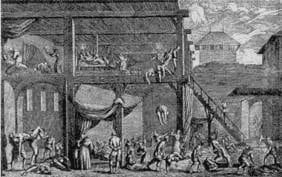ペスト」という言葉はもともと、伝染病で致死的な性質を持つ病気全般を指す言葉だった。 そのため、天然痘、チフス、肺ペスト、皮膚ペスト、泡ペストを幼少期に区別するのは非常に難しい。 ローマ皇帝マルクス・アウレリウスはウィーンでペストで死んだと言われている。
最も壊滅的なペストの流行は 、1348年から1350年にかけて起こったことが知られている。 当時のヨーロッパの人口の約4分の1に当たる約2500万 人が犠牲になった。 ウィーンも人口の3分の2を失ったと推定されている。 秩序は崩壊し、生き残った者たちは「無法者」となった。 死体は、家の中に閉じ込められるのを避けるために、夜になると路上に並べられた。
発生前の数年間は、深刻な災害が 特徴的だった。巨大な蛾や蜘蛛、ミミズ、甲虫、ネズミが急速に蔓延し、移動性のイナゴの大群が畑を食い荒らした。 地震が国を揺るがし、不作と飢饉が人口を弱体化させた。 恐ろしい黒さの彗星のような天体現象は、この病気の原因としての神の怒りを裏付ける役割を果たした。
この伝染病は瞬く間に広まったが 、これはおそらく、当時の衛生状態が壊滅的であったことと、巡礼者の移動が多かったことが原因であろう。 1345年まで、ウィーンでは “プライベット “は知られていない。 2軒の家の住人が共通の玄関を共有していることが多かった。 立ち退きは家主の責任である。 せいぜい、糞便は ティーフェン・グラーベンとローテントゥルム通りにある掃き溜めの役割を果たす小川に流され、やがてドナウ川の次の支流に流れ込んだ。
悪臭は 耐え難いものだったに違いない。 許容できない悪臭の迷惑行為に関する苦情の多くは、公文書館に保存されている。 この “汚染された “空気も伝染病の原因と疑われ、燻蒸が命じられ、病人は悪臭のする地面からできるだけ高い場所に隔離された。
1349年の大疫病の 際には、家々の前に糞尿やゴミが散乱し、その中に多数の豚が根を下ろしていた。 中世を通じて、町にはまだ農家や厩舎があった。 家畜が飼われ、動物たちが通りを歩き回っていた。 路地が掃除されるのは、王子の入内など特別な祝祭のときだけだった。 道路舗装の最初の請求書は1358年にさかのぼる。 井戸はしばしば浸出液で汚染されていた。 家を出るときは木製のオーバーシューズ、いわゆる “トリッペン “を履いた。
ペストは数年ごとに繰り返しウィーンの街を苦しめた。次の流行は1360年、1381年、1399年、1404年、1410年、1428年と続いた。この頻度と乳幼児死亡率の高さを考えれば、平均寿命がわずか24歳だったのも理解できる……あるいは、次の流行まで……。
タイムトラベルのヒント Time Travelを訪れ、1679年の最後のペスト大流行を体験しよう。



